Ode to Summer Rolls
The warm weather finally seems to be sticking around. There was that week-long heat wave last month, followed by a return to seasonal temperatures, then an unseasonal chill. But it seems like things are back to normal now, and Spring is gradually turning into Summer. And for those days when it feels just a little too hot to turn on the stove or the oven, what better than to have Vietnamese summer rolls for dinner?
Granted, they do require a good deal of prepping, so they aren't exactly for the faint of heart. One way to minimise the workload is to have everyone make their own rolls. It still leaves quite a bit of chopping to do, but most of the prep can be done up to a day ahead if necessary. While it is difficult to judge how much everyone will end up eating, it should be fair to assume that most adults will scarf down about four to six large rolls each as a main course. The 'recipe' below takes these amounts into account. The vegetables listed are most commonly found in summer rolls, but do feel free to substitute with whatever you may prefer or already have on hand. In fact, any combination of vegetables can be used: just think of summer rolls as Vietnamese salad wraps.
Vietnamese Summer Rolls
Makes enough for 1 adult as a main course
1 medium carrot, peeled
2 Lebanese cucumbers or ½ an English cucumber
1 generous handful each mint and coriander leaves
2 spring onions
1 sprig Thai basil or 5 shiso leaves, optional
1 Baby Gem lettuce or 3 butterhead lettuce leaves
1 small bundle bean thread or rice vermicelli
6 sheets rice paper, 22cm/8.6" in diameter
Additionally, the following can be added for variety and to account for everyone's taste:
½ bell pepper
⅙ daikon or 6 regular radishes
1 bunch enoki or 6 shiitake mushrooms
¼ beet or kohlrabi
3 stalks stem broccoli, steamed or blanched
½ green or ripe mango or ¼ papaya
4-6 large prawns
1 block soft or fried tofu or ¼ firm tofu
⅓ chicken breast or 1 thigh
80g/3oz beef (rump or chuck) or pork (tenderloin or belly)
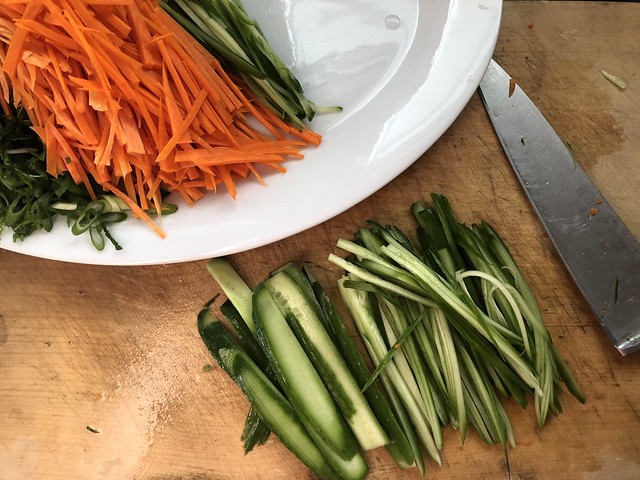
There is a fair bit of chopping to do, but there are ways around that bit of hard work: if you own a mandoline or a spiralizer, then producing copious amounts of shredded vegetables should be a cinch. If your knife skills are not up to scratch, and you do not own any fancy kitchen gadgets, a vegetable peeler can be handily used to slice vegetable ribbons. But, whatever you do to your veggies, please avoid graters: you'll end up with a juicy mess - better to cut your vegetables into small-ish sticks instead. If using mushrooms, they should be cooked before hand: simmer equal parts soy sauce and water, add sugar to taste, and cook the mushrooms for about 5 minutes; drain the mushrooms and allow to cool before serving. The cooking liquor can also be used to season tofu, if using. Lettuce leaves can be left whole (slice butterhead leaves in half) for wrapping around the outside of the roll, or shredded finely to use as a filling.

Bean thread used to come in big bundles that were nearly impossible to separate out in its raw form. However, it can now be found in packs of small bundles, making it easier to cook a single portion. If bean thread are not available, substitute with thin rice noodles or vermicelli. The noodles need to be cooked in boiling water, just like pasta. Unfortunately, timing will vary greatly from brand to brand, so do try to fish out a strand after about 3 minutes of boiling to check if they're done, and keep checking every minute until the noodles are soft. Drain the bean thread and rinse under cold water until completely cooled. Once completely cooled, shake out any excess water, and cut randomly with some scissors. The noodles can be flavoured with a drizzle of sesame oil and soy sauce, if desired, or simply toss with vegetable oil so that they're easier to handle.

Once all the vegetables are prepped and laid out on a platter, you're pretty much set to go, unless you want a protein of some sort. Vegetarian options include all manners of tofu, sliced into sticks: Asian shops, and increasingly more supermarkets, often stock firm tofu that can be marinated and baked, or smoked tofu that is ready to use as is. I prefer soft tofu even though it is more fiddly to handle, but my favourite is fried tofu: Japanese fried tofu (used as the wrapper for inarizushi) is thin and can be turned into crispy morsel by toasting in an oven or a frying pan (no need for extra oil as they tend to be rather greasy); Chinese style fried tofu is usually sold as cubes, and can be sliced into sticks -it might benefit from being seasoned with some soy sauce. Of course, you can go off-piste, and add (vegan or dairy) cheese sticks or vegetarian deli slices.
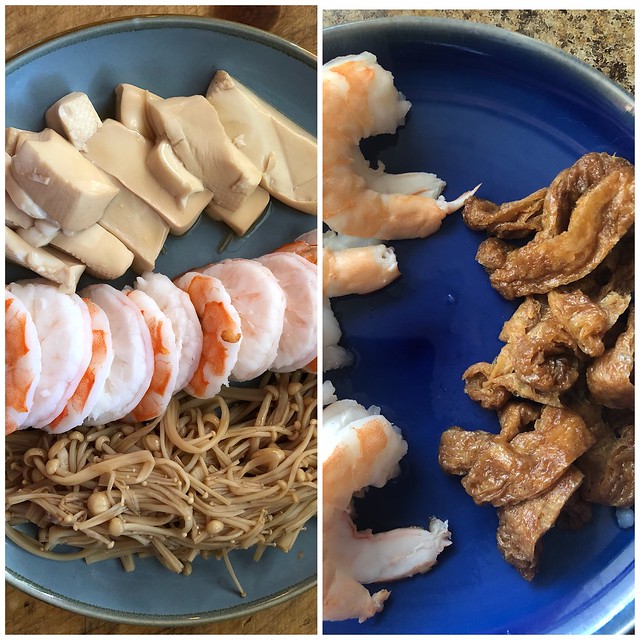
Non-vegetarians have a few additional options: prawns, chicken, beef or pork are usually gently poached until cooked through, then sliced thinly, but they can also be pan-fried if preferred. The poaching liquor can be flavoured with lemongrass or basil stalks, if available: bring up to the boil, then throw in the protein. For prawns, remove the pan from the heat, and allow to sit for 3 minutes, before draining and slicing. Other meats will take about 10-15 minutes on a medium-low heat, depending on the cut, and can be left to cool down in the poaching liquor. Since all the ingredients for summer rolls need to be cold for rolling, proteins can be cooked up to a day ahead of time, and allowed to chill completely before being sliced thinly and served.
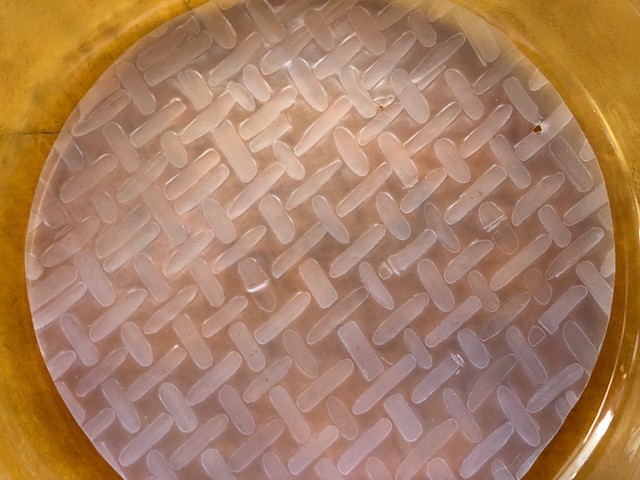
Although rice paper comes in several sizes, the larger ones are easier to handle for summer rolls, so try to buy the 22cm/ 8.6" ones. Depending on the size of your dining table, try to account for at least one bowl of cool water for every two to four diners. Each person should dip their own rice paper, and place it, still dripping wet, on their plate. It is extremely important that the rice paper not be allowed to soak too long: it should no longer feel brittle, but still be somewhat stiff, no more than 5 seconds.

Leaving a wide margin on all sides, stack a bit of whichever filling you like. It doesn't need to look orderly, or even pretty.
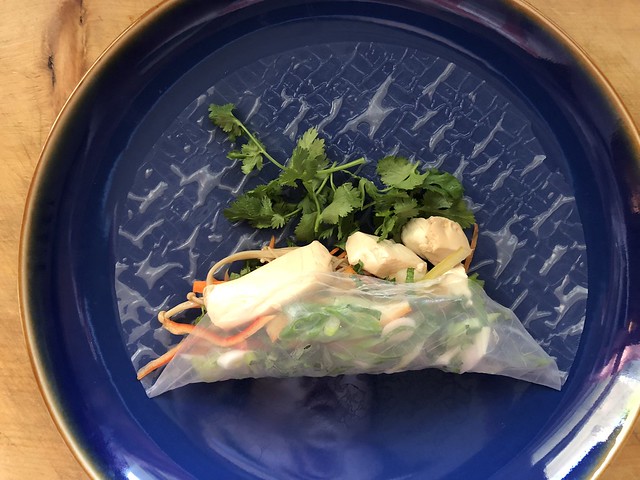
If you do want to make it look pretty though, layer a few herb leaves just shy of the top. Fold up the bottom edge, the rice paper should have softened up by now, and become a little tacky.

Tuck in the sides, making sure they stick to the bottom edge.
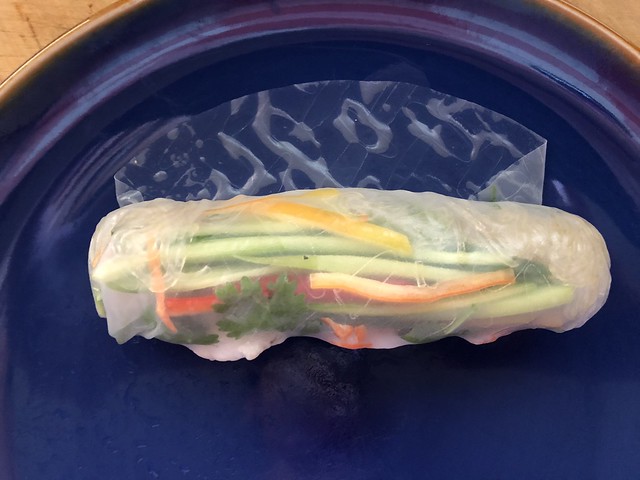
And roll up as tightly as you can manage, without tearing the rice paper. It does take a little practice, but it is easier than rolling up a tortilla wrap!
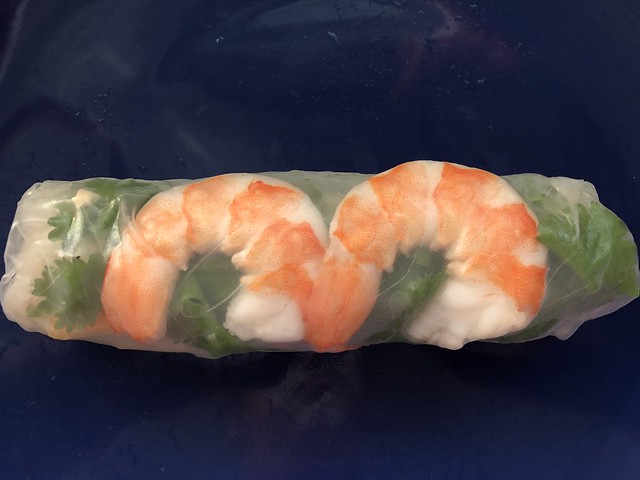
Once rolled, you are ready to tuck in. If you are making summer rolls ahead of time, each roll should be wrapped in a lettuce leaf to prevent it sticking to its neighbour. If possible, try to avoid refrigerating the rolls, as it will render the rice paper opaque: as all the ingredients are either raw or fully cooked, summer rolls should be okay to hang out in the kitchen for up to 45 minutes before . Serve with a dipping sauce of your choice: I am quite partial to this peanut sauce, thinned down with water until it reaches a pouring texture.
Bon App'!

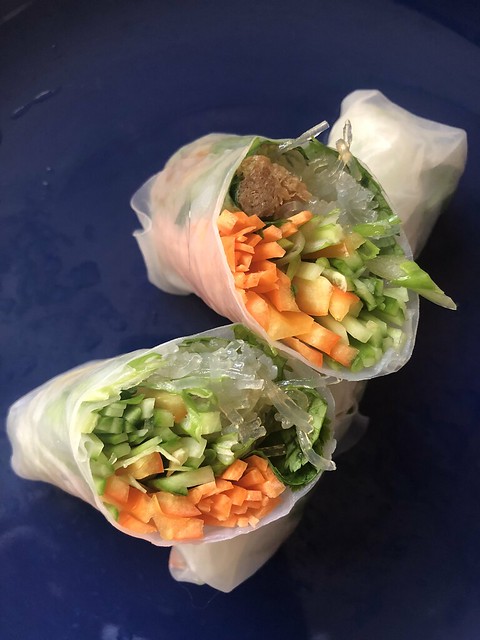
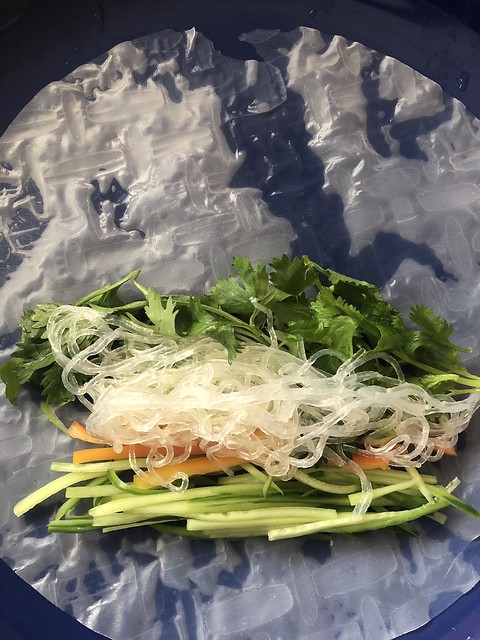
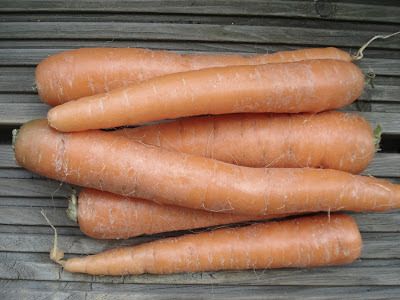

Comments
Post a Comment